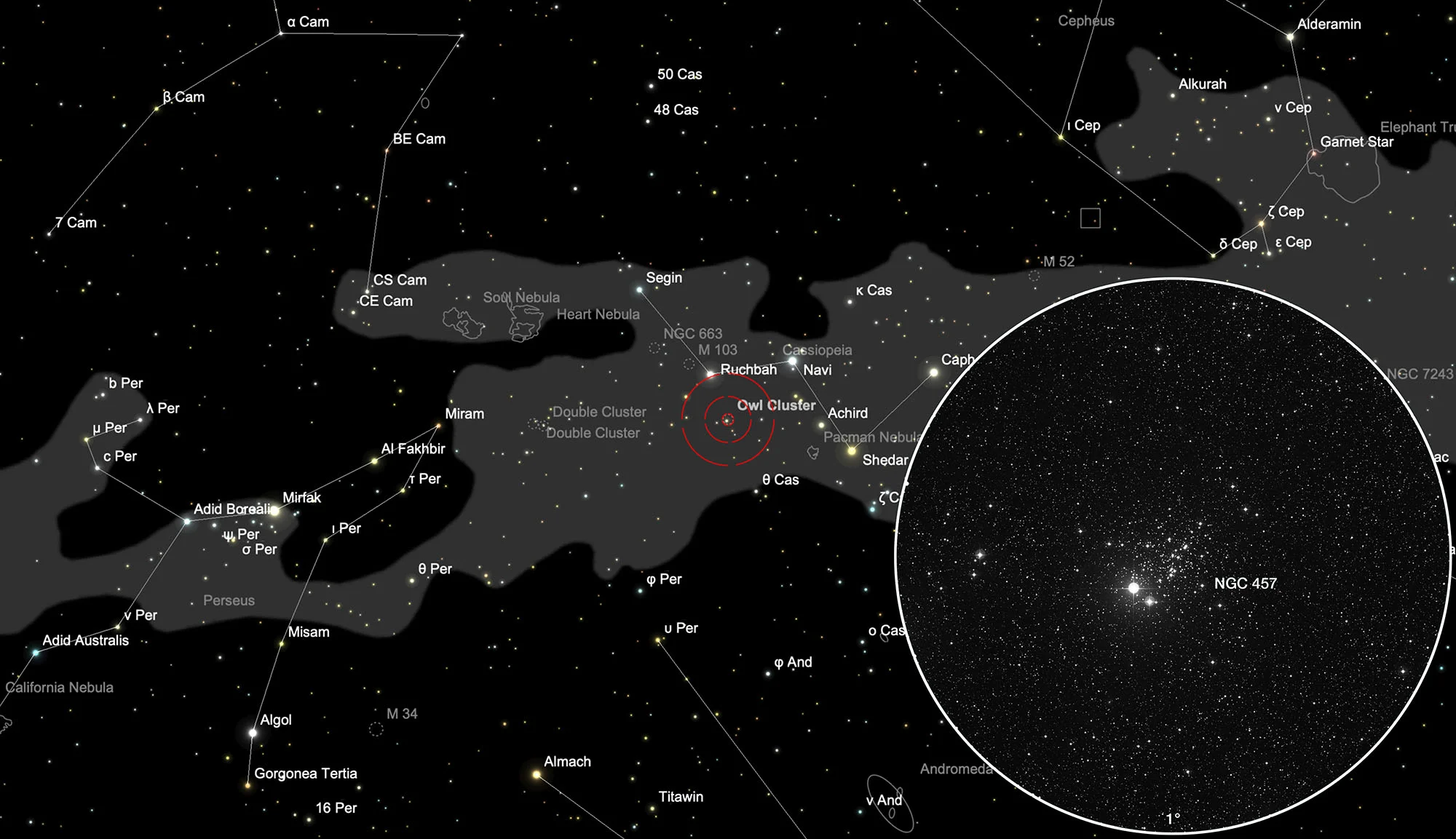Owl Cluster, E.T. (NGC 457)

History
The star cluster was discovered on 18 August 1780 by the German-British astronomer William Herschel with its 6.2 inch reflector and cataloged as VII 42. [277]
The pattern formed by the stars of this open star cluster is reminiscent of an owl with outstretched wings and the two bright stars phi Cassiopeiae and SAO 22187 as shining eyes. For this reason he was given the nickname Owl Cluster.
Based on Steven Spielberg's 1982 movie «E.T. - The Extraterrestrial», the name E.T. for the same star cluster. The shape of the cluster is reminiscent of the short body of the extraterrestrial with its long arms. He seems to have just pulled his big head and is looking at you with his big, round, googly eyes. He stretches out his long arms to "phone home".
A rather unimaginative and rarely used name is Phi Cassiopeiae Cluster, named after the brightest star it contains.
Physical Properties
NGC 457 is a bright, galactic star cluster in the star-rich areas of the Cassiopeia Milky Way. It is an abundantly dispersed group of star points, with an apparent diameter of one to two dozen arc minutes and contains about 100 stars brighter than 13th magnitude. About 60 of these have been identified as true members of the cluster. The stellar population of this group is similar to that of the binary cluster h & χ Persei, including, that NGC 457 is also relatively young. The brightest star is a red super giant of the type M0 and lies in the densest part of the cluster. Its apparent magnitude is 8.6 mag and its absolute -5.2 mag, which corresponds to 10,000 times the luminosity of the sun.
The bright star φ Cassiopeiae has an apparent magnitude of 5.0 mag and the spectral type F0. It is not yet clear whether the star actually belongs to the star cluster. According to this, it would have to be 9300 light years away, would be one of the brightest known stars and would even surpass Rigel in luminosity. The absolute brightness, after the correction by the light absorption by interstellar gas, would then be -8.8 mag, which corresponds to 275'000 times the luminosity of the sun. Membership in the star cluster has not yet been definitively proven, but measurements of the radial velocity, studies of the polarization in the cluster, the lack of measurable proper motion and the spectrum, which corresponds to that of a very bright supergiant, support this assumption. For comparison: the sun at the same distance as φ Cassiopeiae would be just 17.3 magnitudes bright. [4]
| Designation | NGC 457 |
| Type | OCL (I3r) |
| Right Ascension (J2000.0) | 01h 19m 33.0s |
| Declination (J2000.0) | +58° 17' 42" |
| Diameter | 20 arcmin |
| Visual magnitude | 6.4 mag |
| Metric Distance | 2.429 kpc |
| Dreyer Description | Cl, B, L, pRi, st 7, 8, 10 |
| Identification, Remarks | WH VII 42; h 97; GC 256; OCL 321 |
How to find the Alien Owl?
The Owl Cluster is very easy to find. The owl's left eye is formed by the star φ Cassiopeiae, which is 5th magnitude and is still clearly visible to the naked eye on clear nights. On the menu, however, the owl almost does a headstand. NGC 457 is at 1 November to the Sun.
Visual Observation
300 mm Aperture: This star cluster is always a beautiful sight, like E.T. standing there with big, shining eyes, arms outstretched, wanting to phone home. — 300 mm f/4 Popp-Newton, Hasliberg, SQM 20.9, 18. 10. 2025, Bernd Nies
762 mm Aperture: The open star cluster NGC 457 has the eponymous shape of an owl. Or is it ET, phoning home, immortalised in the firmament? The cluster also contains a strikingly bright red star. — 30" f/3.3 SlipStream Dobsonian, Hasliberg, 18. 10. 2025, SQM-L 21.02, Eduard von Bergen
